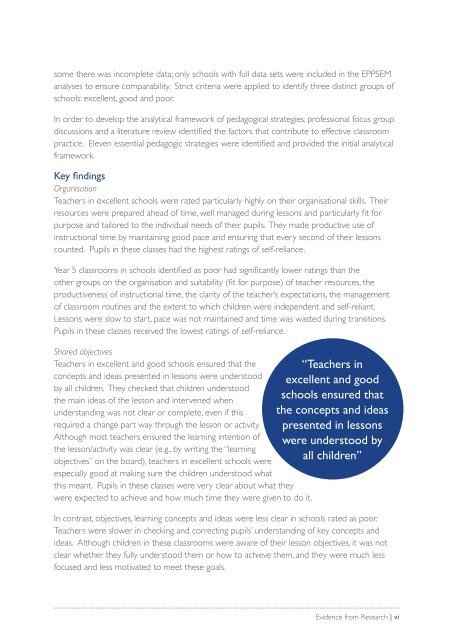Pearson-Exploring-Effective-Pedagogy-in-Primary-Schools
Pearson-Exploring-Effective-Pedagogy-in-Primary-Schools
Pearson-Exploring-Effective-Pedagogy-in-Primary-Schools
Create successful ePaper yourself
Turn your PDF publications into a flip-book with our unique Google optimized e-Paper software.
some there was <strong>in</strong>complete data; only schools with full data sets were <strong>in</strong>cluded <strong>in</strong> the EPPSEManalyses to ensure comparability. Strict criteria were applied to identify three dist<strong>in</strong>ct groups ofschools: excellent, good and poor.In order to develop the analytical framework of pedagogical strategies, professional focus groupdiscussions and a literature review identified the factors that contribute to effective classroompractice. Eleven essential pedagogic strategies were identified and provided the <strong>in</strong>itial analyticalframework.Key f<strong>in</strong>d<strong>in</strong>gsOrganisationTeachers <strong>in</strong> excellent schools were rated particularly highly on their organisational skills. Theirresources were prepared ahead of time, well managed dur<strong>in</strong>g lessons and particularly fit forpurpose and tailored to the <strong>in</strong>dividual needs of their pupils. They made productive use of<strong>in</strong>structional time by ma<strong>in</strong>ta<strong>in</strong><strong>in</strong>g good pace and ensur<strong>in</strong>g that every second of their lessonscounted. Pupils <strong>in</strong> these classes had the highest rat<strong>in</strong>gs of self-reliance.Year 5 classrooms <strong>in</strong> schools identified as poor had significantly lower rat<strong>in</strong>gs than theother groups on the organisation and suitability (fit for purpose) of teacher resources, theproductiveness of <strong>in</strong>structional time, the clarity of the teacher’s expectations, the managementof classroom rout<strong>in</strong>es and the extent to which children were <strong>in</strong>dependent and self-reliant.Lessons were slow to start, pace was not ma<strong>in</strong>ta<strong>in</strong>ed and time was wasted dur<strong>in</strong>g transitions.Pupils <strong>in</strong> these classes received the lowest rat<strong>in</strong>gs of self-reliance.Shared objectivesTeachers <strong>in</strong> excellent and good schools ensured that theconcepts and ideas presented <strong>in</strong> lessons were understoodby all children. They checked that children understoodthe ma<strong>in</strong> ideas of the lesson and <strong>in</strong>tervened whenunderstand<strong>in</strong>g was not clear or complete, even if thisrequired a change part way through the lesson or activity.Although most teachers ensured the learn<strong>in</strong>g <strong>in</strong>tention ofthe lesson/activity was clear (e.g., by writ<strong>in</strong>g the “learn<strong>in</strong>gobjectives” on the board), teachers <strong>in</strong> excellent schools wereespecially good at mak<strong>in</strong>g sure the children understood whatthis meant. Pupils <strong>in</strong> these classes were very clear about what theywere expected to achieve and how much time they were given to do it.“Teachers <strong>in</strong>excellent and goodschools ensured thatthe concepts and ideaspresented <strong>in</strong> lessonswere understood byall children”In contrast, objectives, learn<strong>in</strong>g concepts and ideas were less clear <strong>in</strong> schools rated as poor.Teachers were slower <strong>in</strong> check<strong>in</strong>g and correct<strong>in</strong>g pupils’ understand<strong>in</strong>g of key concepts andideas. Although children <strong>in</strong> these classrooms were aware of their lesson objectives, it was notclear whether they fully understood them or how to achieve them, and they were much lessfocused and less motivated to meet these goals.Evidence from Research | vi


